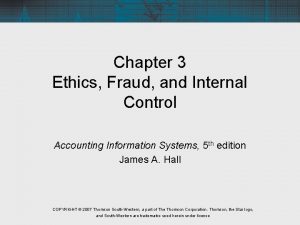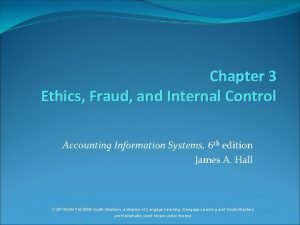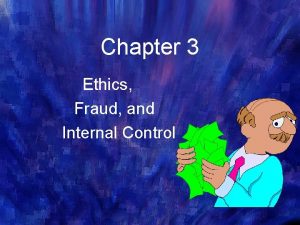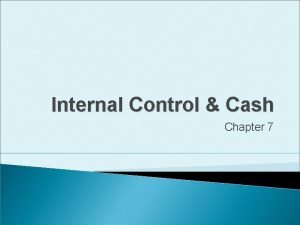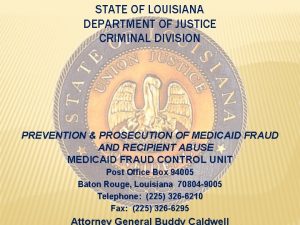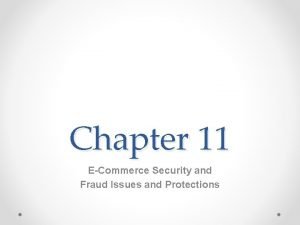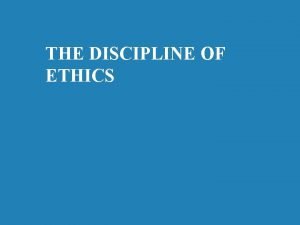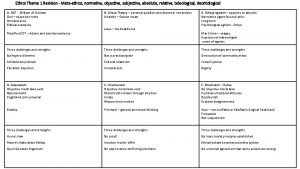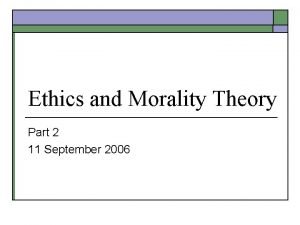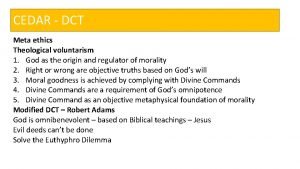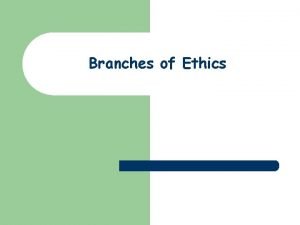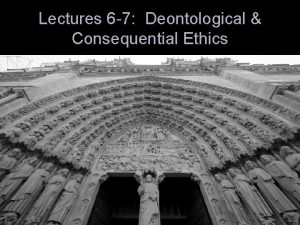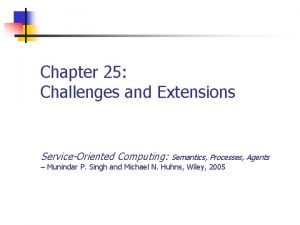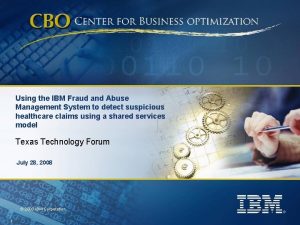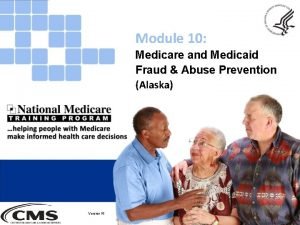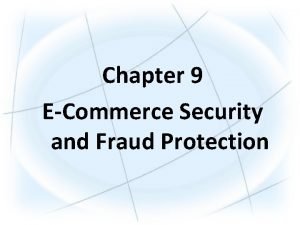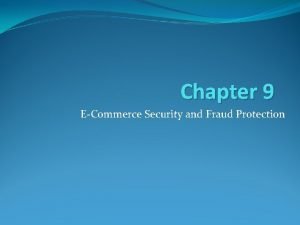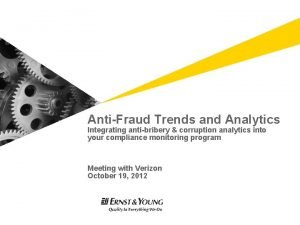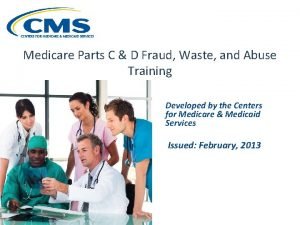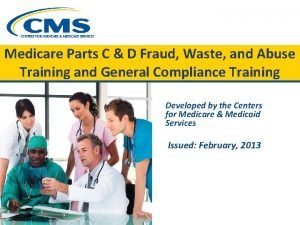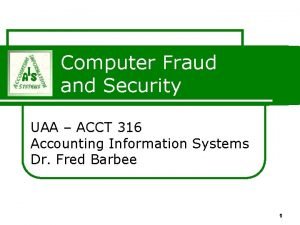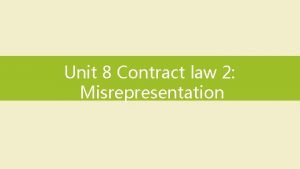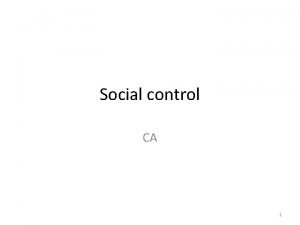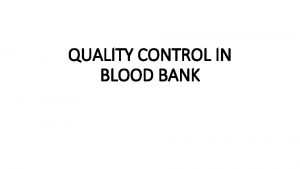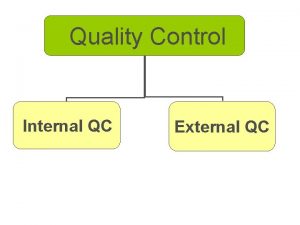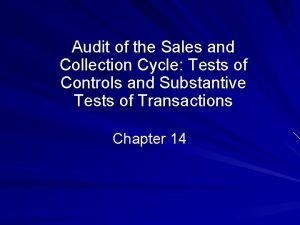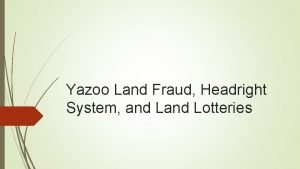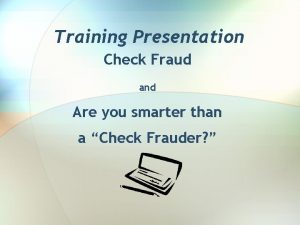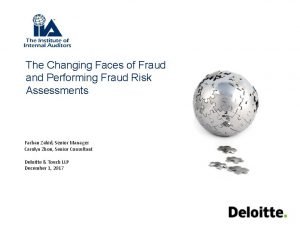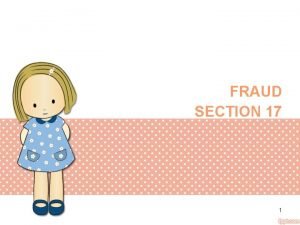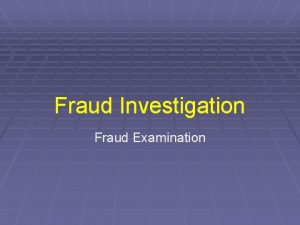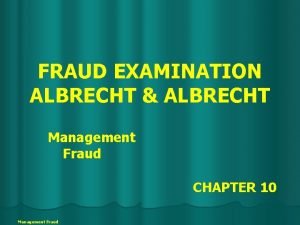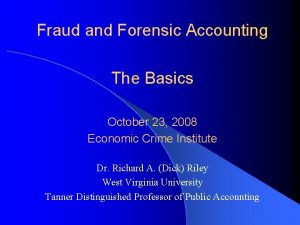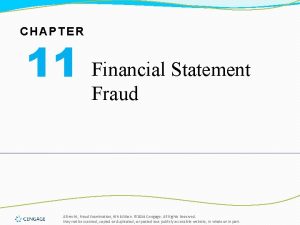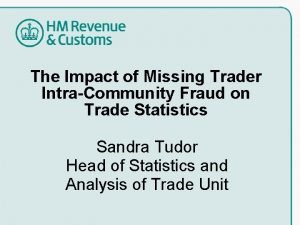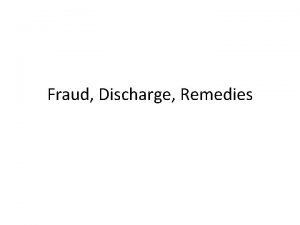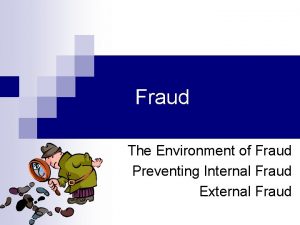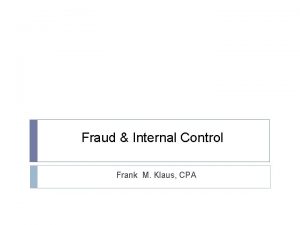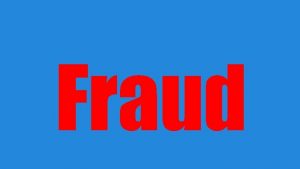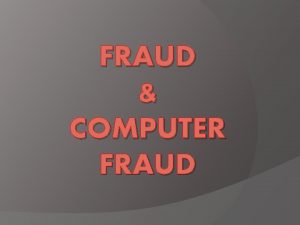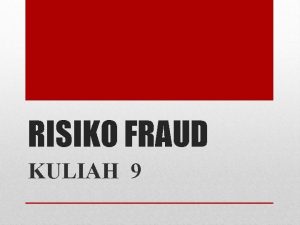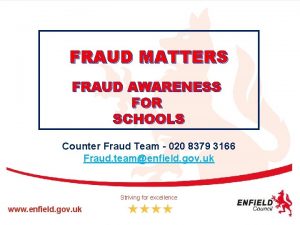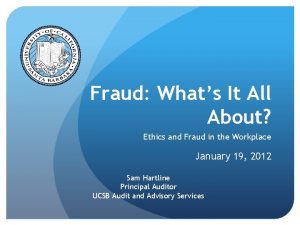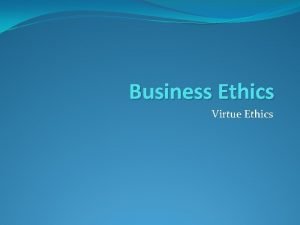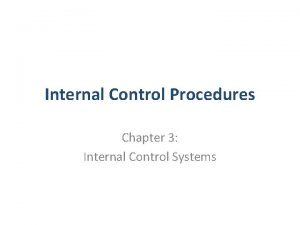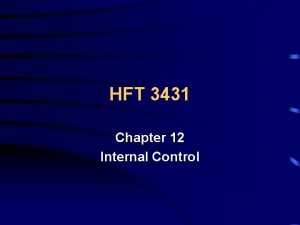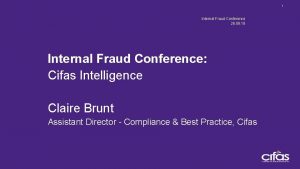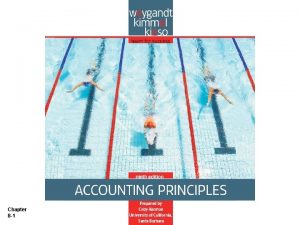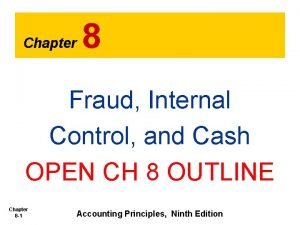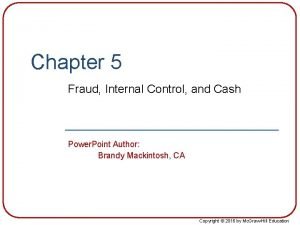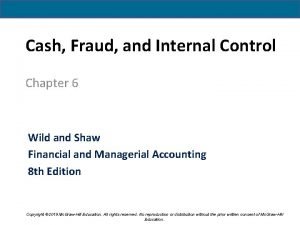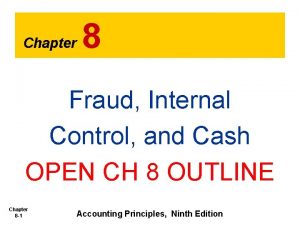Chapter 3 Ethics Fraud and Internal Control Chapter

















































- Slides: 49

Chapter 3 Ethics, Fraud, and Internal Control Chapter 3 -1

Business Ethics Pertains to the principles of conduct that individuals use in making choices and guiding their behavior in situations that involve the concepts of right and wrong Business Ethics involves finding the answers to two questions: How do managers decide on what is right in conducting their business? Once managers have recognized what is right, how do they achieve it? Chapter 3 -2

Business Ethics Ø Ø Ø Business organizations have conflicting responsibilities to their employees, shareholders customers, and the public. Every major decision has consequences that potentially harm or benefit these constituents. For example, implementing a new computer information system within an organization may cause some employees to lose their jobs, while those who remain enjoy the benefit of improved working conditions Chapter 3 -3

Computer Ethics Ø The use of information technology in business had a major impact on society and thus raises significant ethical issues regarding computer crime, working conditions, privacy, and more Ø Computer ethics is “the analysis of the nature and social impact of computer technology and the corresponding formulation and justification of policies for the ethical use of such technology. This includes Ø software as well as hardware and concerns about networks connecting computers as well as computers themselves Chapter 3 -4

What are the main computer ethics issues? Privacy: People desire to be in full control of what and how much information about themselves is available to others, and to whom it is available Security: accuracy and confidentiality; Computer security is an attempt to avoid such undesirable events. Security systems attempt to prevent fraud and other misuse of computer systems Ownership of property: what an individual (or organization) can own. Ideas? Media? Chapter 3 -5

What are the main computer ethics issues? Ø Equity in access: Several factors, some of which are not unique to information systems, can limit access to computing technology. . How can hardware and software be designed with consideration for differences in physical and cognitive skills? What is the cost of providing equity in access? For what groups of society should equity in access become a priority? Ø Environmental issues Chapter 3 -6

What are the main computer ethics issues? Ø Unemployment and displacement Many jobs have been and are being changed as a result of the availability of computer technology. People unable or unprepared to change are displaced Ø Misuse of computer Copying proprietary software, using a company’s computer for personal benefit. Why do people think that it is not necessary to obey this law? What harm is done to the software developer when Chapter people make unauthorized copies? 3 -7

Fraud Ø Ø Ø a false representation of a material fact made by one party to another party with the intent to deceive and induce the other party to justifiably rely on the fact to his or her detriment. False representation - false statement or disclosure Material fact - a fact must be substantial in inducing someone to act Intent to deceive must exist The misrepresentation must have resulted in justifiable reliance upon information, which caused someone to act The misrepresentation must have caused injury or loss Chapter 3 -8

Fraud in the business environment has a more specialized meaning. It is an intentional deception, misappropriation of a company’s assets, or manipulation of its financial data to the advantage of the perpetrator Chapter 3 -9

Employee fraud 1. 2. 3. is generally designed to directly convert cash or other assets to the employee’s personal benefit. Employee fraud usually involves three steps: stealing something of value (an asset), converting the asset to a usable form (cash), and concealing the crime to avoid detection. Chapter 3 -10

Management fraud Top management may engage in fraudulent activities to drive up the market price of the company’s stock. This may be done to meet investor expectations or to take advantage of stock options that have been loaded into the manager’s compensation package. Chapter 3 -11

Management fraud typically contains three special characteristic: 1. 2. 3. The fraud is perpetrated at levels of management above the one to which internal control structures generally relate. The fraud frequently involves using the financial statements to create an illusion that an entity is healthier and more prosperous than, in fact, it is. If the fraud involves misappropriation of assets, it frequently is shrouded in a maze of complex business transactions, often involving related third parties Chapter 3 -12

Factors that Contribute to Fraud (1) situational pressure, which includes personal or job-related stresses that could coerce an individual to act dishonestly. (2) opportunity, which involves direct access to assets and/or access to information that controls assets, (3) Ethics , which pertains to one’s character and degree of moral opposition to acts of dishonesty Chapter 3 -13

Factors that Contribute to Fraud Chapter 3 -14

Fraud Schemes Ø Three categories of fraud schemes according to the Association of Certified Fraud Examiners: A. Fraudulent statements B. Corruption C. Asset misappropriation Chapter 3 -15

Fraudulent Statements Misstating the financial statements to make the copy appear better than it is Usually occurs as management fraud May be tied to focus on short-term financial measures for success May also be related to management bonus packages being tied to financial statements Chapter 3 -16

Corruption involves an executive, manager, or employee of the organization in collusion with an outsider. Bribery: involves giving, offering, soliciting, or receiving things of value to influence an official in the performance of his or her lawful duties. Illegal Gratuities: involves giving, receiving, offering, or soliciting something of value because of an official act that has been taken. This is similar to a bribe, but the transaction occurs after the fact Chapter 3 -17

Corruption Conflicts of Interest, Every employer should expect that his or her employees will conduct their duties in a way that serves the interests of the employer. A conflict of interest occurs when an employee acts on behalf of a third party during the discharge of his or her duties or has selfinterest in the activity being performed. When the employee’s conflict of interest is unknown to the employer and results in financial loss, then fraud has occurred. Chapter 3 -18

Corruption Economic extortion is the use (or threat) of force (including economic sanctions) by an individual or organization to obtain something of value. The item of value could be a financial or economic asset, information, or cooperation to obtain a favorable decision on some matter under review Chapter 3 -19

Asset Misappropriation Most common type of fraud and often occurs as employee fraud Ø making charges to expense accounts to cover theft of asset (especially cash) Ø Transaction fraud involves deleting, altering, or adding false transactions to divert assets to the perpetrator. Ø Lapping involves the use of customer checks, received in payment of their accounts, to conceal cash previously stolen by an employee. Chapter 3 -20

Computer Fraud Schemes Theft, misuse, or misappropriation of assets by altering computer-readable records and files Theft, misuse, or misappropriation of assets by altering logic of computer software Theft or illegal use of computer-readable information Theft, corruption, illegal copying or intentional destruction of software Theft, misuse, or misappropriation of computer hardware Chapter 3 -21

Data Collection Fraud The objective is to ensure that event data entering the system are valid, complete, and free from material errors. if the input data is inaccurate, processing will result in inaccurate output. Two rules govern the design of data collection procedures: Relevance; The information system should capture only relevant data. Only data that ultimately contribute to information are relevant. The data collection stage should be designed to filter irrelevant facts from the system. Efficient § data collection procedures are designed to collect data only once. Chapter 3 -22

Data Collection Fraud Capturing the same data more than once leads to data redundancy and inconsistency. Information systems have limited collection, processing, and data storage capacity. Data redundancy overloads facilities and reduces the overall efficiency of the system. Inconsistency among data elements can result in inappropriate actions and bad decisions. Chapter 3 -23

Data Processing Fraud Data processing frauds fall into two classes: program fraud and operations fraud Program fraud includes the following techniques: 1. Creating illegal programs that can access data files to alter, delete, or insert values into accounting records; 2. Destroying or corrupting a program’s logic using a computer virus. 3. Altering program logic to cause the application to process data incorrectly Chapter 3 -24

Data Processing Fraud Operations fraud is the misuse or theft of the firm’s computer resources. This often involves using the computer to conduct personal business. For example, a programmer may use the firm’s computer time to write software that he sells commercially Chapter 3 -25

Database Management. Database management involves three fundamental tasks: storage, retrieval, and deletion Database management fraud includes altering, deleting, corrupting, destroying, or stealing an organization’s data. Chapter 3 -26

Definition of Internal Control § § § Policies, plans, and procedures Implemented to protect a firms assets People Involved Ø Board of directors Ø Management Ø Other key personnel Chapter 3 -27

Definition of Internal Control Ø The reason this is important is that these individuals want reasonable assurance that the goals and objectives of the organization can be achieved (i. e. , effectiveness and efficiency of operations, reliability of financial reporting, protection of assets, and compliance with applicable laws and regulations) Chapter 3 -28

Internal Control System Objectives Ø Safeguard assets Ø Check the accuracy and reliability of accounting data Ø Promote operational efficiency Ø Enforce prescribed managerial policies Chapter 3 -29

Types of Controls Preventive Controls Ø reduce the frequency of occurrence of undesirable events. Ø Prevent problems from occurring. Ø a company might install a firewall to prevent unauthorized access to the company’s network, thereby safeguarding the disclosure, alteration, or destruction of sensitive information from external hackers Chapter 3 -30

Types of Controls Detective Controls alert managers when the preventive controls fail As an example, Ø assume that a company’s information system prepares daily responsibility accounting performance reports for management that computes variations of actual production costs from standard production costs. If a significant variance occurs, a manager’s report signals this problem and the manager can initiate corrective action Chapter 3 -31

Types of Controls Detective Controls Organizations can initiate corrective action only if corrective controls are in place. A company establishes corrective controls to remedy problems it discovers by the detective controls. Chapter 3 -32

Types of Controls Corrective controls Ø Solve or correct a problem Ø Corrective controls are actions taken to reverse the effects of errors Ø detected in the previous step Chapter 3 -33

Internal Control Framework Ø Framework consists of five components: 1. the control environment, 2. risk assessment, 3. information and 4. communication, monitoring, and control Chapter 3 -34

The Control Environment Ø Ø is the foundation for the other four control components The control environment sets the tone for the organization and influences the control awareness of its management and employees § The integrity and ethical values of management. § The structure of the organization. § The participation of the organization’s board of directors and the audit committee, if one exists. § Management’s philosophy and operating style. § The procedures for delegating responsibility and authority. § Management’s methods for assessing performance. Chapter 3 -35 § External influences, such as examinations by regulatory

Risk Assessment Ø Identify, analyze and manage risks relevant to financial reporting. Ø changes in external environment Ø risky foreign markets Ø significant and rapid growth that strain internal controls Ø new product lines Ø restructuring, downsizing Ø changes in accounting policies Chapter 3 -36

Information and Communication The AIS should produce high quality information which: Ø identifies and records all valid transactions Ø provides timely information in appropriate detail to permit proper classification and financial reporting Ø accurately measures the financial value of transactions Ø accurately records transactions in the time period in which they occurred Chapter 3 -37

Monitoring The process for assessing the quality of internal control design and operation Ø Separate procedures; internal auditors test the control and communicate the control strength and weakness management. Ø Ongoing monitoring; § computer modules integrated into routine operations § management reports which highlight trends and exceptions from normal performance Ø allow management and auditors to maintain constant surveillance over the functioning of internal controls Ø Chapter 3 -38

Control Activities Ø Ø • • Policies and procedures to ensure that the appropriate actions are taken in response to identified risks. Fall into two distinct categories IT controls—relate specifically to the computer environment Physical controls—primarily pertain to human activities Chapter 3 -39

Control Activities Two Types of IT Controls General controls—pertain to the entity wide computer environment Ø Examples: controls over the data center, organization databases, systems development, and program maintenance Application controls—ensure the integrity of specific systems Ø Examples: controls over sales order processing, accounts payable, and payroll applications Chapter 3 -40

Control Activities Physical Controls This class of controls relates primarily to the human activities employed in accounting systems Transaction Authorization Ø The purpose of transaction authorization is to ensure that all material transactions processed by the information system are valid and in accordance with management’s objectives. Ø General authority is granted to operations personnel to perform day-to-day operations Example the procedure to authorize the purchase of inventories from a designated vendor only when inventory levels fall to their predetermined reorder points. Chapter 3 -41

Control Activities Physical Controls Transaction Authorization Specific authorizations deal with case-by-case decisions associated with nonroutine transactions. An example of this is the decision to extend a particular customer’s credit limit beyond the normal amount. Specific authority is usually a management responsibility Chapter 3 -42

Control Activities Physical Controls Segregation of Duties Ø The segregation of duties should be such that the authorization for a transaction is separate from the processing of the transaction. Ø For example, the purchasing department should not initiate purchases until the inventory control department gives authorization. Ø This separation of tasks is a control to prevent individuals from purchasing unnecessary inventory Chapter 3 -43

Control Activities Physical Controls Segregation of Duties Responsibility for the custody of assets should be separate from the record-keeping responsibility. For example, the department that has physical custody of finished goods inventory (the warehouse) should not keep the official inventory records. Accounting for finished goods inventory is performed by inventory control, an accounting function Chapter 3 -44

Control Activities Physical Controls Supervision Ø Ø Implementing adequate segregation of duties requires that a firm employ a sufficiently large number of employees The firm employs competent and trustworthy personnel The competent and trustworthy employee assumption promotes supervisory efficiency. Firms can thus establish a managerial span of control whereby a single manager supervises several employees Chapter 3 -45

Control Activities Physical Controls Accounting Records Ø Consist of source documents, journals, and ledgers. Ø These records capture the economic essence of transactions and provide an audit trail of economic events Ø The audit trail enables the auditor to trace any transaction through all phases of its processing from the initiation of the event to the financial statements Chapter 3 -46

Control Activities Organizations must maintain audit trails for two reasons: First, this information is needed for conducting day-to-day operations. The audit trail helps employees respond to customer inquiries by showing the current status of transactions in process. Second, It enables external (and internal) auditors to verify selected transactions by tracing them from the financial statements to the ledger accounts, to the journals, to the source documents, and back to their original source. Chapter 3 -47

Control Activities Access Control Ø The purpose of access controls is to ensure that only authorized personnel have access to the firm’s assets. Unauthorized access exposes assets to misappropriation damage, and theft. Ø Therefore, access controls play an important role in safeguarding assets. Access to assets can be Ø Direct Physical security devices, such as locks, safes, fences, and electronic and infrared alarm systems, control against direct access. Ø Indirect access to assets is achieved by gaining access to the records and documents that control the use, ownership, and disposition of the Chapter asset 3 -48

Chapter 3 -49
 Chapter 3 ethics fraud and internal control
Chapter 3 ethics fraud and internal control Sas 78/coso
Sas 78/coso Internal control shield
Internal control shield Controlsbond
Controlsbond Chapter 7 fraud internal control and cash
Chapter 7 fraud internal control and cash Imprest system
Imprest system Fraud, internal control, and cash
Fraud, internal control, and cash How do fraud symptoms help in detecting fraud
How do fraud symptoms help in detecting fraud Internal control introduction
Internal control introduction Audit report of a company
Audit report of a company Louisiana medicaid fraud control unit
Louisiana medicaid fraud control unit Differentiate micro-ethics and macro-ethics.
Differentiate micro-ethics and macro-ethics. E commerce security and fraud issues and protections
E commerce security and fraud issues and protections Descriptive ethics vs normative ethics
Descriptive ethics vs normative ethics Descriptive ethics vs normative ethics
Descriptive ethics vs normative ethics Aspects of honesty
Aspects of honesty Meta ethics vs normative ethics
Meta ethics vs normative ethics Descriptive ethics vs normative ethics
Descriptive ethics vs normative ethics Descriptive ethics vs normative ethics
Descriptive ethics vs normative ethics Meta ethics vs normative ethics
Meta ethics vs normative ethics Three branches of ethics
Three branches of ethics Deontological ethics example situation
Deontological ethics example situation Teleological ethics vs deontological ethics
Teleological ethics vs deontological ethics Ibm fraud and abuse management system
Ibm fraud and abuse management system Fraud and abuse module
Fraud and abuse module E commerce security and fraud protection
E commerce security and fraud protection E-commerce security and fraud protection
E-commerce security and fraud protection Computer fraud and abuse techniques
Computer fraud and abuse techniques Anti bribery and corruption analytics
Anti bribery and corruption analytics Fraud waste and abuse training answers
Fraud waste and abuse training answers Fraud waste and abuse training answers
Fraud waste and abuse training answers Computer fraud and security
Computer fraud and security Misrepresentation vs fraud
Misrepresentation vs fraud Characteristics of social control
Characteristics of social control Blood bank quality control
Blood bank quality control External and internal quality control
External and internal quality control Uncollectible account authorization form
Uncollectible account authorization form Yazoo land fraud cartoon
Yazoo land fraud cartoon Sfcu medford ny
Sfcu medford ny Risk assessment fraud
Risk assessment fraud De re de dicto
De re de dicto Lau hee teah v hargill engineering sdn bhd
Lau hee teah v hargill engineering sdn bhd Risk assessment fraud
Risk assessment fraud Evidence square fraud
Evidence square fraud Fraud exposure rectangle
Fraud exposure rectangle Fraud triangle accounting
Fraud triangle accounting What is fraud exposure rectangle
What is fraud exposure rectangle Missing trader intra-community (mtic) fraud
Missing trader intra-community (mtic) fraud Missing trader intra-community fraud
Missing trader intra-community fraud Yazoo land fraud definition
Yazoo land fraud definition
